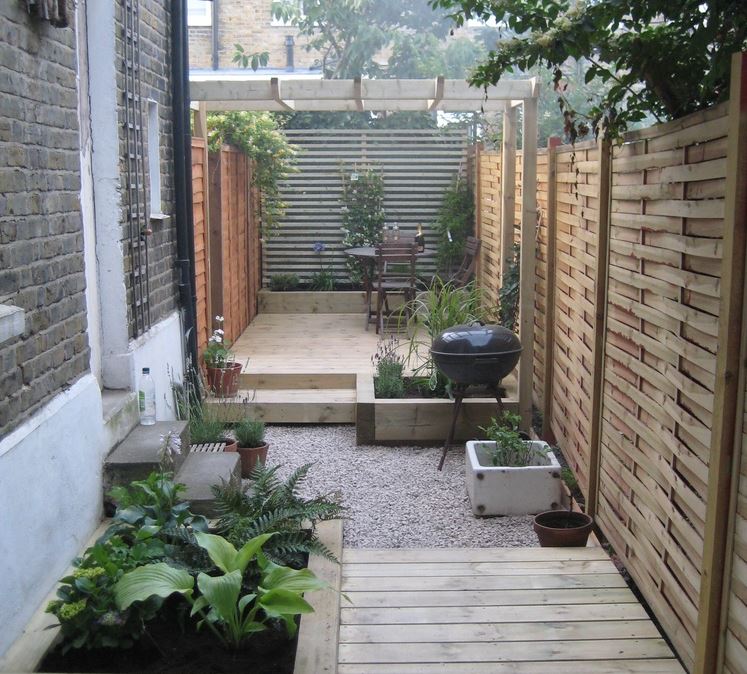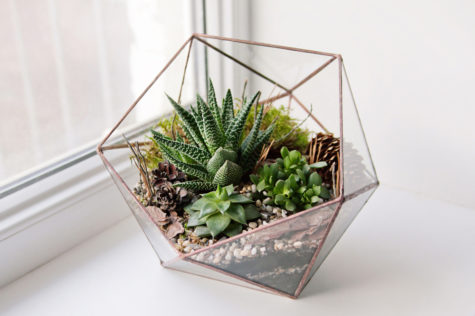Long, narrow gardens are a staple in British towns and suburbs. The thing is, the dimensions of a long garden can be quite tricky unless you’ve lived (and gardened) in them your whole life.
So maybe you’ve moved house and have suddenly found yourself with a stretch of outside space – or have had one for a while and need some inspiration for a revamp. Either way, you’re in the right place for all of our best tips and ideas for long gardens.
The Challenges of a Long, Narrow Garden
Let’s take a quick look at some of the biggest challenges with a long strip of outdoor space and whether there’s anything that can be done to balance them out.
Challenge: Lack of Privacy
Everyone wants to feel like they can sit outside without being watched, but that can be a struggle in terraced houses (which are usually the ones that come with long, narrow gardens). You’re often overlooked by neighbouring houses, dealing with fences that aren’t quite high enough… or both.
Ultimately, you’re not going to get complete privacy when you’re living in a built-up area. There are a few ways that you can sneak in some privacy, which we’ll talk about in a sec. The main thing to remember is, when you’re planning your layout, the most private spot will usually be close to your own rear wall.
Challenge: Too Much Shade
Depending on which way they face, tightly-packed terraced houses can often prevent the sun from reaching their own garden. If you have 6ft fences on either side of your garden, well, be glad you have the privacy, but you’re probably losing even more light!
The good news is that there are plenty of plants that are happy in the shade. Also keep in mind that your garden may actually be getting more sun than you realise. If you don’t usually get out there until late afternoon or early evening, try checking whether there’s more sunshine earlier in the day – you might be surprised!
Challenge: Awkward Shape
When it comes to planning in a garden that’s long and thin, the first thing people usually struggle with is simply visualising what can be done with the space. This is especially true when the garden seems barely wide enough to fit a shed, or tapers off awkwardly at one end.
Don’t worry. We’ll start by looking at some layout ideas for long, narrow gardens that can be adapted to all kinds of awkward shapes, and will hopefully get you looking at your strip of land in a new light.
Layout Ideas for Long Gardens
When you’re dealing with an awkward space, getting the layout right is essential. In long gardens, you’re particularly trying to avoid the unflattering “corridor” effect, where the eye is drawn straight to the back fence because everything else is arranged in a column.
1. What are your “must-have” garden features?
Take the time to plan out your sections properly and you’ll be amazed at how well everything else falls into place. As a minimum, you’ll want to take some measurements and sit down with some pencil and paper to get planning.
Start by thinking about what features you’re expecting to include:
- Flower beds, or borders?
- Vegetable or herb-growing areas?
- A lawn, patio or deck?
- A path?
- Sheds, greenhouses or storage?
- Structures, like a pergola or gazebo?
This incredibly narrow garden still has plenty going on. There’s the seating area (made possible thanks to slimline garden furniture), a planter for growing vegetables, and lots of flowers that maximise the vertical space with shelves and hanging baskets (which can also be used for vegetables).
2. Create “rooms” with purpose
With these in mind, start planning a way to break up the length of your garden. In long gardens, the best way to do this is to create several sections, each with a different purpose. For example, you might have an intimate seating area at the far end, shielded from view by a shed and/or vegetable patch, with a square or circular patch of lawn and a patio closest to the house. Plan how you want to use each area to get the most out of the space you have.
This garden is essentially a side-return, but clever landscaping makes the most of every metre. There’s an intimate seating section, a cosy BBQ area, a pergola and heaps of sections for plants. It even looks like they’re using borrowed scenery by letting the neighbour’s plants flow over the tops of the fences.
3. Design a winding, varied path
Avoid using a single straight path down the middle length of your garden, which will make it seem like a corridor and cut each section in half. Instead, try a curving path or – better yet – change the style of walkway between outdoor “rooms”. Combine stepping stones, wooden paths, paving, gravel and having no path as suits your style.
See how the stepping stone path means that the lawn looks unbroken? It means this long garden looks much wider, but it’s still practical. Also, the curves make room for much larger flower beds and features that would make a symmetrical garden look more crowded – which bring us onto our next point…
4. Asymmetry will help the proportions of your space
Finally, remember that your garden doesn’t need to be symmetrical, at all. A narrow floral border on one side will give you colour, while still making space for lawns, growing patches, sheds, hot tubs or whatever else you like in the rest of the space. If you’re left with any little nooks, use them for hidden seating spots, like a garden swing chair.
This long garden has a simple layout, but the off-centre path means that the left side looks wide (even if it’s only a visual trick that makes you compare it to the rights side). It’s subtle, sure, but a centred path would really just make this space look like an alleyway.
How to Divide a Long Garden Into Sections
Dividing each space can be as simple as some crisp garden edging, or you can use fences, screens, shrubs, potted plants, arches or distinct changes in terrain or height. It’s generally better to keep the boundary of each section subtle – something you can see when you’re there, but that doesn’t obscure your view from the house too much.
5. Make every hide and reveal deliberate
It’s up to you to decide what works best, and where you want to create a sense of “hide and reveal” as you walk through the garden. What do you want to be immediately visible, and which areas should come as a delightful surprise as someone walks through.
You could try putting a see-through structure in the middle of your garden to break up the length without blocking it. For example, an open-sided pergola, or a greenhouse with glass at both ends.
In this garden, irregular-shaped flower beds create organic screens that add an air of mystery. Your eye follows the paving through the length of the garden and the shallow steps create “rooms” – but what’s inside? You’ll have to wander through to find out.
6. Levels are the secret to success
Creating different levels is a really effective way to break up the space. If your garden is on a hill, you could build up the end of your garden to create a beautiful viewing terrace, and level other challenging parts of your space at the same time. If your garden is already flat, try digging a sunken gravel bed and/or building a deck to create shallow differences in height and texture.
Even a few steps can create different spaces in your garden. In this garden, it looks like the raised area by the door is for delicate pots and flowers, while the larger, lower area is wilder and greener. It even looks like there’s an additional lower-ground section at the back – perfect for a secret seating area.
7. Embrace hardscaping
Don’t be nervous about having a large patio or several hardscaped seating areas. They’re incredibly functional and will make it easier to be outside and enjoy your space. Make an outdoor living room for yourself with a weatherproof rug and comfy garden seats, as well as a BBQ area with a table for dining al fresco.
Choosing decking doesn’t mean you compromise on greenery, as you can see with this garden. Stepping down through hedges, rose shrubs and big planters is like being cocooned by nature. It’s simple and beautiful.
Choosing Plants for a Narrow Garden
There are two things to contend with when picking plants for a narrow garden: space and shade.
8. Don’t stress about shade
Finding the space for growing is easy once you start looking in the right places.
Seeking sunlight will take some patience – you’ll want to observe different areas of your garden throughout the day (and across the seasons) to see where you get the most concentrated light. Most plants acclimated to the UK will be just fine with four hours of sunshine a day.
9. Start with containers
While you’re still figuring out where you can permanently plant everything so it thrives, get stuff growing in pots. You can always transfer stuff into the ground later!
Pots are good for the long-term too though. They’re an easy way to introduce structure, colour and texture into your garden design without it being overwhelming. Plus, you can swap them around endlessly to showcase seasonal plants in bloom.
The pots on this patio can easily be swapped and rearranged throughout the year. Plus, having a seating area at the bottom of the garden gives you more of an excuse to get down there.
10. Plant vertically to maximise sunshine
If you figure out that only a few slivers of your garden get enough sunlight for happy plants, you’ve got to make the most of them. Any containers that let you stack plants vertically are your friends in this scenario. Check out pots that hang from fences or drain pipes, and take a look at some easy DIY pallet shelves for inspiration. Look for ledges, hooks, brackets and anywhere else you can stand or hang your pots.
11. Top five plants for a narrow garden
- Lavender is very happy to grow in tight spaces, like a narrow border. It’s a great low-maintenance bloom for the far end of your garden, provides beautiful colour and sells divine as you walk past.
- Stipa tenuissimacan be used to create an organic semi-screen when you’re trying to define sections of your garden or snag some privacy. It grows up to 60cm tall, so think about whether you want it in the ground or in raised planters for the best effect.
- Honeysuckle is another plant with a gorgeous aroma, and it will happily climb up trellises to shield you from view. If you wish that your neighbours couldn’t see straight into your rear windows, try growing honeysuckle up and over them to give you a few more feet to yourself.
- Jasmine will do a similar thing, actually, so I’m going to add that to this list! You can fix string horizontally between a fence and a pergola or shed to encourage Jasmine to creep across, and it also smells beautiful.
- Verbena bonariensis is popular in long, terraced gardens. In summer, they can shoot up to almost six feet, and tend to grow upwards much more than outwards. You can get a pretty, organic curtain without sacrificing square footage.
Styling Ideas for Long Gardens
Here are a few final tips for utilising a long, narrow garden in the best possible way, and making it look cohesive.
12. Match your hardscaping materials
Dividing a long, narrow garden into sections is pretty common advice. However, the space can look disjointed if you use too many different colours and materials. Even if you’re combining stone patios, wood fences, metal planters and brick edging, make sure there’s harmony in the shapes and shades. Include your shed, decking, furniture and garden structures, too.
In this garden, the grey stepping stones, fencing and edging match, and the pots are in a similar shade to the bricks and patio.
13. Look for shapes and patterns
The geometry of your garden materials is just as important as their colour when you’re trying to create visual illusions. The long rectangles in the furniture, paving, fencing and planters of this narrow courtyard emphasise its length.
14. Use your shed strategically
Talking of sheds, make sure that yours is working as hard as possible so you can use it for different purposes throughout the year. In autumn, take the time to tidy up the inside and invest in tool storage, and in winter you can enjoy the extra space as a cosy garden she-shed or man-cave retreat. In spring, you’ll want to reclaim the space as a potting shed, but if you can transform it into a home bar for summer, you’ll get maximum enjoyment from your garden.
15. Paint your fence to reflect light
If light and shade really is a challenge in your garden, make sure your fence isn’t working against you. Dark hues, although elegant, will be sucking up whatever sunlight creeps in – switch to white, cream, pastels or a pale wood stain to start bouncing some of that light into your shady flower beds and corners.
16. Protect your privacy

When it comes to privacy vs. sunlight, it’s basically guaranteed that you and your neighbours will want different things. So, pick a few key areas to defend your sanctuary and accept that you will, occasionally make eye contact with your neighbours and have to suffer their summer radio choices.
Building a pergola or gazebo is one way to shield yourself from view. Although both structures tend to be somewhat open to the elements, you can find gazebos with solid sides that can be strategically angled. Similarly, adding panels or trellises to a pergola will afford you a bit more privacy without completely blocking the sun and breeze.
Trellises are also the answer if you’re struggling with mesh fences, too. If you suspect your neighbours will fuss about using their fence as a support, choose freestanding ones that will still support a healthy volume of climbing plants to create a kind of green curtain.
Of course, having a summer house or shed-based retreat of some kind (also known as a she-shed or man-cave) will give you somewhere to enjoy your garden without being exposed – although I suppose you’ll technically be inside, perhaps defeating the point.
17. Keep the far end low-maintenance

Let’s be real. Even if you like to have a coffee outside each morning, you’re unlikely to make it down to the end of a long garden every single day. Do yourself a favour and put a patio and evergreens at the bottom of the garden, which won’t mind if you don’t keep them pruned for a while.
So, those are some of the most effective ideas for long gardens and narrow outdoor spaces – don’t forget to check out some of our other tips for unusual outdoor spaces, like ideas for rooftop gardens and balconies. What kind of tips do you want to see next?

Save this pin for later






















